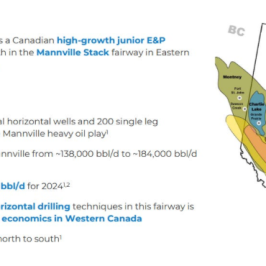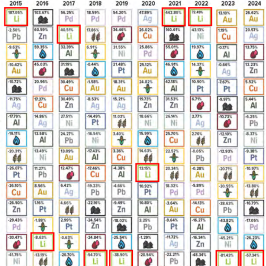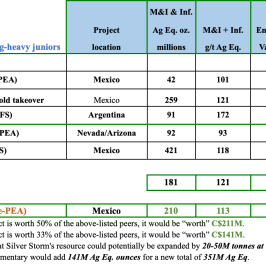Canada has ~1,850 metals/mining/minerals producers, developers & explorers, ~12x more than there are Canadian-listed oil & gas names.
Finding highly prospective, cheaply valued oil juniors is difficult, but if accomplished it can be quite rewarding.
Iran/Iraq, the Middle East, and Russia ALL in the news this week…
Of course, the big news this week is Israel’s surprise attack on Iran, described as the most significant military action inside of Iran since the 1980s. As of June 13th, Israel’s military is warning of a, “prolonged operation.”

WTI crude oil is trading at ~US$73/bbl, up from a low of ~$55/bbl in late-April/early-May. There had been doom & gloom in the oil sector due to OPEC increasing production & weak global economies.
Yet, China’s economy is closer to the end of a multi-year slowdown than the beginning. A possible war between Israel/Iran, new sanctions/stronger enforcement of sanctions on Iran and/or Russia could meaningfully offset OPEC supply additions.
Last month Statista was forecasting WTI to average US$55/bbl. next year. Now, COMEX futures through 12/31/27 range between $64.0 & $71.5/bbl. WTI averaged $82.65 from 1/1/22 to 12/31/24.

Geopolitical risks are high. Events tied to Iran & Iraq (world’s 5th largest producer!) or Russia could add another $10+/bbl in a heartbeat.
In a dangerous & unpredictable world, I believe the assumption that WTI will remain under $75 for years to come is unwarranted. There are attractive opportunities for cashed up juniors that can drill high impact wells with WTI at $60 (currently ~$73).
The goal is to get low-cost, low-risk, prolific wells drilled & producing, and benefit from a further rebound in price, even if it’s a few years before WTI rises sustainably above $75 again.

An unknown, new producer is Westgate Energy, (TSX-v: WGT) / (OTCQB: WGTFF) a small but rapidly growing heavy oil producer focused on the Mannville Stack fairway of East-Central Alberta.
There are few companies like Westgate to choose from — funded & growing production very fast. Several others in Western Canada are privately-held. I believe Westgate stands out as a high-risk/high-return opportunity.
Don’t let its size fool you, the team is excellent. Founder & CEO Rick Grafton is a passionate, hard-working & highly successful executive with over three decades’ experience in investment banking & capital markets, mostly for Canadian oil/gas juniors.
Rick was a co-Founder of First Energy Capital, along with N. Murray Edwards (currently Exec. Chair of Canadian Natural Resources). First Energy was a powerhouse in Canada’s energy sector from the mid-1990s to 2016.
Stacked mgmt. team for this exciting Mannville Stack opportunity!

Current production is from the Company’s Killam Sparky Mannville asset purchased in Q2/23. The first multi-lateral well was drilled there in Dec. 2023.
Westgate Energy receives game-changing US$25M loan commitment
Despite producing an average of 259 barrels of oil equivalent (“boe“)/day in 1Q/25, and the Company having a market cap of ~$9.5M ($0.135/shr.), Westgate received a senior secured loan for up to US$25M = C$34M (US$10M drawn, maturing April-2029).
An additional US$10M is approved & available for drawdown. One can hardly imagine the hoops Westgate’s team had to jump through to obtain such a meaningful loan based on a few hundred boe/d!

Vetting of the Mannville Stack, the Company’s land position & the management team/board was rigorous. Texas-based lender Cibolo Energy Partners, LLC is an expert in oil/gas, managing ~US$500M in assets. This loan is a huge vote of confidence.
Cibolo bought into a tremendous growth trajectory, a narrative I believe is both compelling & achievable. From 259 boe/d, management expects to reach ~1,000 boe/d by Jan./Feb., and 2,000+ by 1Q/27.
If JV’s and/or acquisitions are done, growth could be even higher. As it stands, if the team can deliver [2,000/259 boe/d = +672% growth in under two years, Westgate could be the fastest growing producer in N. America.
The Mannville Stack hosts well defined medium & heavy oil resources. Multiple prospective shallow horizons (~300-900 m), result in lower drilling costs, reduced “spud to on-stream” times, and quicker paybacks.
Mannville Stack fairway has several operational advantages

High porosity & permeability allow wells to flow without the need for stimulation such as hydraulic fracturing. Therefore, the Mannville Stack offers a cheaper entry point than the Montney & Duvernay.
Note: In the above bar graph showing total net inventory, the 153 locations assumes the acquisition of Moonshine (14.5 sections) later this year.
Getting to 1,000 boe/d will require drilling eight wells in 2025, three of which should be completed in June. One of the three will be a “fishbone,” where a horizontal well is drilled with 6-8 shorter side branches or laterals —like fish ribs— extending from it.
The other two will be less expensive conventional horizontal wells with no laterals. If a conventional horizontal well can produce nearly as much as a fishbone, then management will stick with conventional drilling.
Besides lower costs, a benefit of going conventional is more wells per section, perhaps twice as many. They’re also less complex, so they can be drilled faster. A detailed cost/benefit analysis of each approach will be done soon after the three wells are flowing.
“If we look at Canada, where conventional oil production has stayed relatively flat for 25+ years, it’s examples like the multilateral drilling technology being used in places like the Clearwater & Mannville Stack, along with frac design, unlocking the Montney & Duvernay, along with condensate growth, that are backfilling the decline and keeping overall conventional oil production flat.”
—David Spyker, CEO Freehold Royalties Ltd
Importantly, these are not high-risk or deep wells, and this is not exploration drilling. Everyone knows the oil is there — it’s a question of costs, flow rates, and decline rates, (payback periods, IRRs). Will the economics be good, or very good at $70 WTI?
Nothing beats funded, exponential production growth in great locations!
There are an estimated 40 horizontal multi-lateral well locations crossing through 3 or 4 stacked, shallow zones at Westgate’s Beaverdam property in the Mannville Stack.
If conventional wells offer superior economics, there could be up to 16 well locations per section — enough to keep the team busy into 2027.
Management has six [1,609 x 1,609 meter] sections, a signed purchase agreement on a 14.5-section parcel, and is in discussions with much larger players willing to farm out acreage they might never get around to drilling.

Companies like Cenovus Energy & Canadian Natural Resources, with thousands of sections each, have numerous blocks that are far too small to act on. Yet small blocks can be company-makers for firms the size of Westgate ($9.5M market cap).
The pending 14.5-section Moonshine acquisition, at an estimated net cost of ~$5.7M, was earmarked to close in June/July, but has been pushed back. Moonshine has up to 57 horizontal multi-lateral well locations, and 58 boe/d of existing production.
Cibolo did not loan/invest (they own 24.3M warrants at $0.21 vs. the current price of $0.135) based on six sections! They’re backing Westgate in its quest to obtain considerably more sections and grow to 5,000+ boe/d.
Mannville Stack as good/better than surrounding heavy oil plays!

Imagine if management could surpass 5,000 boe/d when WTI is north of $80/bbl. Westgate could be worth C$150M+ (C$30K per flowing boe/d, less debt, which I believe would be under C$50M).
2025-2026 could/should be EPIC for Westgate Energy
In the following indicative C$ economics, notice that next year’s production could average 1,734 boe/d and generate over C$20M in EBITDA at an assumed US$70 WTI price.
Included in the prospective economics is a conservative $15/bbl WCS differential, $6.50/bbl quality adjustment, $0.70 C$/US$ FX rate, and a sliding scale gross overriding royalty (GOR).
A minimum of eight wells are planned for 2025, and 12 in 2026 at a total cost of ~C$1.8M/well.

In my view, upon drilling & completion successes this year, Cibolo would consider investing additional funds if/when attractive opportunities arise. Having strong financial backing is incredibly important.
To reiterate, there are not many currently producing & rapidly growing oil companies with tiny market caps poised for (potentially) large capital gains if pre-funded growth plays out (reasonably) as planned.
Westgate Energy is high risk, but has the right team and is in the right place. Could it be the fastest growing producer in N. America from 2024 to 2027? If so, today’s $9.5M market cap could prove to be an excellent entry point.
Disclosures: Westgate Energy is a speculative, small-cap company. It faces operational (growth) challenges that could become a problem if meaningful delays arise. It has access to debt funding to drill wells, but debt adds significant risk to small cap companies. Oil prices are always a risk, but (some) hedges are in place. Other challenges could pop up. Readers are urged to consult with investment advisors before investing in speculative stocks.
At the time this article was published, Mr. Epstein of Epstein Research owned shares in Westgate Energy purchased in the open market. Westgate is not currently a paying advertiser on Epstein Research but is expected to become one in near the future. Mr. Epstein of [ER] is biased in favor of Westgate Energy.
![Epstein Research [ER]](https://epsteinresearch.com/wp-content/uploads/2025/02/logo-ER.jpg)






Leave a Reply